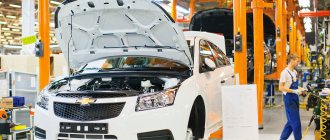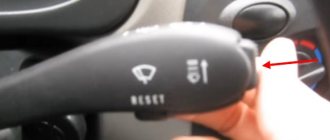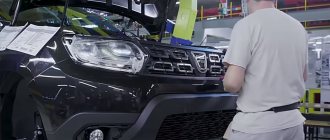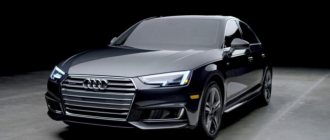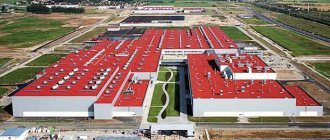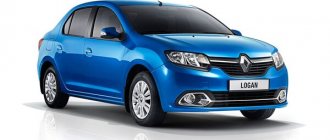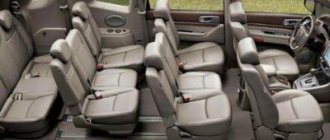The Swedish concern, which produces high-quality and majestic Volvo cars, has become one of the most influential in the European premium car market. This happened in the last seven years, but from 2000 to 2007 the concern did not develop, offering customers the same models with old engines. The secret of the Swedish car company's success lies in its alliance with the Chinese. The formal Geely corporation simply bought out the Swedish enterprise, but the agreement is more like a merger.
The Chinese made a commitment not to rename the brand, to preserve the European Volvo brand, the country of origin should remain Sweden, and Geely does not have the right to use the concern’s technical developments in its cars. I wonder if the Chinese are honoring the signed agreement?
Volvo in Russia
Official sales of Volvo cars in the USSR started in 1989.
It should be noted that truck tractors, so necessary for Sovtransavto, have been purchased since 1973. The Volvo brand... The manufacturing country is located in Northern Europe, in the center of civilization. Currently, the Volvo concern in Russia is also represented by VFS Vostok LLC.
built a new plant in Kaluga. The launch of this production took place on January 19, 2009. The production capacity of this plant is very large. It amounts to 15,000 trucks per year. Installation of Volvo FM and Volvo FH models is planned here. This is the first full-scale production of commercial trucks of a foreign brand in the Russian state. A little later, Volvo Truck Center-Kaluga was built on the Volvo factory territory. This center started operating in the summer of 2009. Volvo Holding has adopted a comprehensive transport solution. Now production, sales and service are carried out in one place.
Representative office in the Russian Federation
Volvo xc90 (Volvo xc 90)
Volvo became the first foreign truck company to supply trucks to the Soviet Union. These were tractors designed for international cargo transportation. And at the moment the company is the leader of the Russian market. Volvo's far-sighted management has long understood the benefits and has been supplying its cars to the country since 1973. Today, every fourth Western-made truck in Russia is a Volvo.
In addition to sales of the cars themselves, the popularity of the brand is facilitated by a wide network of service stations and offices throughout the country from Kaliningrad to Vladivostok. The company owns its own centers in St. Petersburg, Moscow and Kaluga. The assembly of trucks was initially carried out in Zelenograd, however, due to a lack of space, it was later moved to the Kaluga region.
There are more than ten service centers in Russia, the Volvo Group is represented by two and VFS Vostok.
South America
Peugeot: country of origin
Our largest markets in South America are Brazil, Peru, Chile and Argentina. The dominant truck brands are Volvo Trucks and Mack Trucks.
Since the start of production in Brazil in 1977, we have owned two factories in this country. In Curitiba we produce trucks, bus chassis, cabs, engines and gearboxes. In addition, we produce construction equipment in Pederneiras.
Overall results for South America for 2022
• Net sales: SEK 21,138 million (17,241)
• Share of net sales: 5% (5)
• Number of permanent employees: 5,228 (4,774)
• Percentage of permanent employees in the Volvo Group: 6% (5)
• Demand in the important Brazilian truck market grew strongly, increasing by 67% for heavy-duty trucks. • Demand in other South American markets was good
• Demand in other South American markets was good.
Factories in Sweden
If previously Volvo cars had one country of origin (Sweden), today the production of components and assembly are established in many countries. Volvo was once the largest plant in Sweden; today the market dictates its conditions, mostly economic ones. A series of crises will force anyone to sacrifice the principles of patriotism when the question is about ordinary survival.
Volvo's headquarters are located in Gothenburg. The most famous factories in Sweden are located in Skevda, Eskilstuna. The company in Torsland (Gothenburg) is the head office. As part of the program to increase production volumes, it is acquiring new workshops; not so long ago, a body shop was opened for the production of the new XC90. On the territory of the enterprise there are not only assembly shops, but also laboratories and research centers.
The mechanical plant in Eskilstuna was founded in 1832; at one time it produced printing presses, threshers, engines, and the first Swedish steam locomotive and tractor were created there. Today it houses the assembly shops of Volvo Construction Equipment.
Production
Hyundai: country of manufacture and model range
Many people are confused about which country produces Volvo. This is due to the company's extensive product line.
The Scandinavian Peninsula is home to one of the world's most renowned manufacturers of reliable vehicles. Volvo's first producing country is Sweden. Since 1927, it is here, in the city of Gothenburg, that the best cars, parts and components come off the assembly line.
You can find out what Sweden is famous for, besides cars, from our material.
The company specializes in manufacturing:
- trucks;
- passenger cars;
- agricultural and forestry equipment;
- engines for various purposes.
The concern successfully carried out its activities in the automotive industry. Until 1999, the company was producing passenger cars, but then Volvo Personvagnar became the property of Ford, another giant in car production, and later to the Geely concern (China). Today there are several areas of activity of the concern. Despite the fact that the company that owns the Volvo Cars line is located in China, the main production facilities for cars and trucks are still located in the European Union.
European factories of the concern
The main plant remains in Gothenburg, Sweden. This is where cars were originally made. Today the following models are produced:
- XC90;
- V60;
- S80.
The Gothenburg facilities make cars for the markets of Europe and the USA. The share in the total production of all vehicles is about 11%. Not far away, in the city of Skövde, Volvo power units are produced. The engines are distributed all over the world, to countries where the parent company's facilities are located. The conveyors in the city of Olofström produce body parts of the Scandinavian brand. In addition, high-quality products are made in other European countries. So, in Belgium, at the Volvo Cars Ghent plant, located in the city of Ghent, the following models are assembled:
- C30;
- V40;
- S40;
- V50;
- S60;
- XC60.
It is the units assembled in Ghent that have the reputation of being of the highest quality. This is all thanks to the fact that the enterprise is fully equipped with a closed type of production. The plant produces about 33% of cars from the total production volume. In Torsland and Uddevalla in Switzerland, models come off the assembly lines that make up the lion's share of total production - 20%:
- V70;
- XC70;
- S80;
- XC90;
- V601;
- C70.
In addition to the factories presented above, the concern owns bus production in the UK and produces vehicles for various purposes in the USA and China. Assembly factories operate in India and Malaysia.
In Copenhagen, the Volvo concern has a research center where they develop and test innovations in technical transport units. A team of specialists is working on the creation of new models and the introduction of innovations, making the comfortable, bladeless and environmentally friendly vehicles of the Swedish brand even better every day.
Factories in Asia
Since 2013, the company begins producing vehicles at production facilities in the cities of Chengdu and Chongqing in China. Cars are made here for the country's domestic market. The opening of a production base in the country made it possible to significantly reduce the cost of car models due to the absence of customs duties. More than half of all production comes from the Chinese market. They make the following car models:
- S40;
- S60;
- S90.
Since 2015, the concern has been exporting cars to the USA produced in Chinese factories.
Volvo in the USA
The largest market for Volvo vehicles is in North America. Residents of the continent have long been accustomed to the reliability of cars and their high technical characteristics. The largest plant producing passenger vehicles of the brand is the plant located in Ghent. It accounts for about half of the company's total turnover. However, today the concern has its own plant in South Carolina, where it produces models of the 60th class, but it is planned to produce the 90th class as well. This made it possible to fill the American market with reliable and recognized cars. Previously, Volvo only had a research center in the United States.
We described in our article what else you can bring from the USA.
Characteristics and price of geely emgrand x7
The Geely Emgrand X7 compact crossover was introduced to the Russian market in 2013 with an improved design, a basic engine and an excellent automatic transmission. The cabin is comfortable, with comfortable seats, designed for five passengers. Expensive, environmentally friendly materials were used in the interior decoration.
Emgrand X7 is available in three modifications:
- "Standard";
- "Comfort";
- "Luxury".
The power plant is 1.8, 2.0 and 2.4 liters, equipped with manual transmission 5 and automatic transmission 6.
The maximum power of the models is 127, 139 and 148 hp. Average fuel consumption ranges from 8.4 to 11 liters.
The cost of Emgrand X7 “Standart” is from 769 thousand rubles, “Comfort” – 794 thousand rubles, and the “Luxury” model with leather interior, climate control, parking sensors, tinted windows, adjustable seats, etc. - 869 thousand rubles.
Find out more about the latest products in the market and the world of cars on our channel in Yandx.Zen. Subscribe and like!
The history of the creation of the Volvo emblem
Toyota: country of origin. reviews about the brand
In addition to the name, the car must have an emblem. In 1927, the idea of how it should look was born, and not just one. On the nose of the cars there was a circle with an arrow, which at the same time symbolized the Roman god of war, Mars, and was a symbol of iron and masculinity.
However, such a badge had to be somehow secured to the radiator grille. The designers couldn't come up with anything better than installing it using a regular diagonal strip. They didn’t even imagine then that such a stripe would later become an integral part of the Volvo symbol.
In addition, a dark blue oval with the inscription Volvo Gothenburg Sweden was attached under the radiator cap. At the very beginning of the development of the Volvo company, there was no clear standard for the emblem. For quite a long period, designers experimented and modified the symbolism.
The modern emblem is a diagonal stripe with an emblem in the middle. The cars are also equipped with the Volvo logo. The font for it was finally determined in 1958.
Features of a Swede
The manufacturer has thought through the interior of the crossover to the smallest detail. There is plenty of space here, passengers will feel comfortable and comfortable.
The dashboard includes:
- multimedia system
- gsm phone
- auxiliary function control system
- climate control system.
The steering wheel also has additional buttons with which the driver can control and configure the vehicle's systems. Where they produce the Volvo XC90 for Russia, they try to adapt the car as much as possible to our roads. For rear seat passengers, the manufacturer installed audio system control units on the rear pillars. The second row of seats can comfortably accommodate three adults. Each car seat is adjustable and has a folding backrest.
The third row consists of full-size seats; they can be folded together, thereby increasing the volume of the luggage compartment several times. The crossover dimensions are: 4800 mm × 1890 mm × 1740 mm. Maximum speed is 210 kilometers per hour. To accelerate the car to the first hundred with “mechanics” it will take 9.9 seconds. with automatic transmission – 10.3 seconds. It is difficult to call a crossover economical in terms of fuel consumption. In the city, the SUV consumes 16.1 liters of gasoline.
Volvo Technologies
Throughout its history, Volvo has paid particular attention to the development of safety technologies. This Swedish manufacturer was the first to equip its cars with three-point seat belts, triplex laminated windshields and lambda sensors that help reduce emissions.
This Swedish manufacturer was the first to equip its cars with three-point seat belts, triplex laminated windshields and lambda probes - sensors that help reduce exhaust emissions.
In the 1970s, Volvo developed the world's first child protection system - a booster cushion and a special rear-facing child seat.
Much earlier than other companies, Volvo began using its own innovative safety solutions on its cars, such as a system that alerts the driver to another vehicle in a blind spot or a system called City Safety, which prevents collisions at low speeds.
Adaptive security system - what is it?
Volvo specialists are in the eternal search for perfection. The ultimate goal is to develop the safest car in the world. For this purpose, the principles of an adaptive security system are being introduced. The very term “adaptability” (adaptation) means the adaptation of the system to real external conditions. This is a special approach that calls for fighting the cause, not the effect.
In addition, crash tests are carried out in the concern's large garages. For example, a car crashes into a wall at high speed. Dangerous situations such as a collision with a large animal and a fall into a ditch are also simulated. These tests check the strength of the structure. And based on 3D animation, situations are simulated in which the consequences of accidents are studied in detail.
Crash tests of Volvo cars take place under harsh conditions. New requirements introduced by the European independent crash testing committee Euro NCAP were used to evaluate Volvo cars a couple of decades ago.
Emergence and development of the company
The Volvo company originated in 1915 in the Swiss city of Gothenburg, as a subsidiary of SKF, which produced bearings. It was founded by former college classmates Assar Gabrielson, an SKF employee and Gustav Larson. The idea to start a car business came to young engineers in a restaurant over beer and crayfish. After some time, SKF management approved their idea and allocated funds for the development and production of the first cars.
The name Volvo is derived from the Latin verb volvete, which means “I roll.” The Volvo emblem is a symbol of iron and the god of war, Mars, who fought exclusively with iron weapons. The associations that this emblem is supposed to give rise to are reliability and durability.
In 1927, the first Volvo car appeared - an open-top phaeton with a four-cylinder engine. It was called OV4, and also had an unofficial name - Jacob. It was not just the first Volvo car - it was the first car made in Sweden. The Volvo Jacob had a strong beech and ash chassis and sprung seats, a rarity for cars of the 1930s. Engine power 28 hp. could accelerate the car to 90 km/h.
In 1928, Volvo released its first sedan, the PV4, and two years later, its modification, the PV651, with a six-cylinder engine producing 55 hp. With. This model was used as a taxi in Sweden. In the same year, the first Volvo truck, Type 1, rolled off the assembly line.
At the Stockholm Motor Show in 1944, Volvo presented the PV444. This passenger model became the “people's car” in Sweden, due to its high quality at low cost. Initially it was planned to assemble 8,000 cars, however, due to high demand, Volvo produced 200,000 cars. At the same exhibition, the company's first bus, the PV60, with a diesel engine, was presented.
In 1951, Volvo switched to assembly line production. In the same year, the first family car, the Volvo Duete, was released.
In the 80s, the company began producing new generation cars. They featured a modern design and more powerful engines, which were modified to reduce fuel consumption. The main model of the 80s was the 760 sedan, which was equipped with six-cylinder gasoline and diesel engines. It accelerated to 100 km/h in 13 seconds.
Today Volvo is owned by the Chinese concern Geely, which bought it from Ford in 2010 for $1.8 billion. However, Volvo's headquarters remained in Gothenburg.
Volvo model archive
Volvo XC90 I2002
Volvo Cars is a large Swedish manufacturer of cars and commercial vehicles, headquartered in Gothenburg in the southwest of the country. The history of the company begins back in 1915, when the SKF bearing production enterprise was founded. In 1927, Volvo was created as a subsidiary of SKF. Translated into Russian, Volvo means “I’m rolling.” At the same time, the first Volvo car, the OV4, was released. In 1935, Volvo gained independence from its parent company and began developing new models. In 1944, the production car PV 444 was released, which is shown in Stockholm at the Royal Tennis Hall. In the same year, the company produces the PV60 diesel bus. The Volvo Duett station wagon appears in 1953. With this car, Volvo begins to focus on producing family cars. In 1954, Volvo announced a five-year warranty on its cars.
Since 1955, Volvo begins to supply its products to the United States. The appearance of the P 120 car in 1956, which in Scandinavian countries is known as Amazon, surprised the world, since this model had pronounced feminine outlines. In 1958, the Volvo PV 544 won first prize in the European Rally Championship. In 1959, engineer Niels Bohlen created a three-point seat belt, and Volvo was the first to install these belts in production cars. Developed in 1966, the Volvo 144 wins the Car of the Year title for its advanced safety features. In 1967, the first child seat was developed and installed in a car. In 1975, Volvo became the owner of DAF and began selling models of this brand under its own logo. In the same year, the 200 series family of passenger cars appeared; in total, more than 2.8 million of these cars were sold worldwide. In 1982, the Swedish company released the Volvo 760 business sedan, which became one of the safest in the world.
In 1990, Volvo launched its flagship model with the index. In 1995, compact cars Volvo S40 and Volvo V40 went on sale. In 1997, the all-terrain touring model Volvo V70 Cross Country was born. In 1999, Ford Motor Company acquired Volvo Cars. Under the wing of Ford, Volvo is modernizing its model range, and sales of the brand's cars are gradually beginning to rise. In 2000, the sports Volvo S60 was developed, which was very popular in the USA. The Swedish company released its first SUV in 2002 - it was the Volvo XC90, which received wide commercial success. In 2008, the subcompact crossover XC60 was released, which revived interest in the brand's cars against the backdrop of the financial crisis. In 2010, the Chinese concern Geely Automobile became the new owner of Volvo Cars. Currently, Volvo's production base is located in Sweden, Belgium, China and the USA.
Are there other countries in the world where Volvos are assembled?
Many car enthusiasts confuse Sweden with other Scandinavian and European countries, believing that Volvos are assembled in Norway, Switzerland or even Germany. In fact, Volvo Corporation's only plant is located in Gothenburg, Sweden. This enterprise, even after the purchase of the concern by the Chinese, remains in this city and does not reduce its activities.
On the contrary, Chinese investment has given the Swedish company a huge boost. There are several important aspects that changed in 2007:
- money and technical capabilities appeared to develop a completely new model range;
- the efforts of the designers of the already powerful company Geely and the Swedes combined;
- the Volvo brand has received a huge Chinese market, where its cars are sold without unnecessary duties;
- new technologies began to be introduced into cars, thanks to generous investments;
- the plant expanded its staff, improved production lines and received many other benefits.
If we consider the technology of car manufacturers today, we can safely say that Volvo is one of the best factories in Europe. The latest equipment is installed here; all assembly processes are fully automated. The cars are not just of high quality, they finally live up to their price tag. Until 2007, Volvo cars were bought only in Scandinavian countries. They were too expensive and outdated.
Chinese Geely cars after cooperation with the Swedes
Immediately after the merger of European and Chinese manufacturers under the roof of one concern, Geely had new models that were three heads higher than their predecessors. In fact, the entire model range has changed, new engines began to produce more horses, requiring less fuel. And the appearance of the Emgrand series has greatly advanced.
We invite you to enjoy the video test drive of the new Emgrand EC7
Video:
A crossover, which had not been announced before, even appeared in the Geely model line. Such changes are associated with the following development options for the company:
- despite the ban on the use of Volvo technologies, the Chinese pulled certain developments of the Swedes to their side;
- as a result of bilateral cooperation with European engineers, new developments were obtained;
- the company received a good income-generating asset and was able to invest in its own production;
- Engineers from Sweden were invited to work in China.
The last assumption is a tested and proven fact. But Geely denies the fact that this is related to the development of the successful Engrand series of cars. However, for the consumer there is no difference. If a company produces good cars, let it take technology where it is more convenient for it. What is more important for the consumer is how high-quality a car he can purchase at the dealership. That is why the Swedes today are quite happy with their seven-year cooperation with the Chinese.
The plant in Gothenburg is growing and developing, the brand is acquiring new models, and the Geely corporation is fulfilling all its main promises.
history of the company
The company was founded by Assar Gabrielson and Gustaf Larson in 1915. In fact, it was a subsidiary of the popular bearing manufacturer SKF. The first production car, the Jakob OV 4, left the factory gates on April 14, 1927. It had an engine with a capacity of 28 horsepower and a top speed of 90 km/h.
The country is beautiful! Who becomes the president of the concern in 1956? Of course, Gunnar Ingellau! He is a Doctor of Mechanical Engineering and Economic Sciences. During his tenure, the company flourished. Export of Swedish cars to the USA starts in 1956. In the United States in 1957, 5,000 Volvo cars were sold. Car production volume is increasing. In 1956, 31,000 copies were manufactured, and in 1971, 205,000 units were produced.
The country has a temperate climate, mainly due to the Gulf Stream. It's very pleasant to work here. It should be added that Nils Ivar Bolin also worked tirelessly at Volvo. He is the author of the three-point seat belt. For the first time in the world, the Volvo PV 444 and P120 Amazon brands were equipped with this element.
The P1800 model is designed as a two-seater sports coupe. It was released in 1960. And production of the Volvo-144 began in 1966. This particular model was equipped with a dual-circuit braking system. And it was here that the deformable zones of the body were installed. This is an amazing Volvo! Which manufacturing country is capable of inventing such a candy? Of course, only Sweden.
In 1976, the creators of Volvo developed Lambda Sond oxygen sensors. In the same year, the exhaust gas catalytic converter was created.
Volvo Personvagnar's passenger car division was sold to Ford in 1999. The concern was able to sell the division for $6.45 billion. Volvo Personvagnar AB is known in the USA under the name Volvo Cars. And since 1999, this branch has become a division of the Ford concern. But in December 2009, Ford announced the sale of Volvo Personvagnar AB to the Chinese company Zhejiang Geely Automobile. The branch is now worth $1.8 billion. On March 29, 2010, the Chinese company officially signs the documents. These are papers for the acquisition of the Volvo Cars brand from Ford Motor. The deal was completed on August 2, 2010.
Chronological history
To understand how successful the development of Volvo brand production was, let’s briefly consider the history of the company in chronological order:
- 1924 - the idea of creating a car production plant in Sweden emerged.
- 1927 - release of OV4 Jakob. A total of 300 vehicles were produced.
- 1937 - production of models PV51 and PV52, which are similar to each other. A total of 1,800 vehicles were produced.
- 1940s - modernization of products for military needs. Creation of PV Every year 3,000 cars roll off the assembly line.
- 1953 - the Volvo Duett family car was introduced to consumers.
- 1954 - the company began to provide a 5-year warranty period for its products. The first sports car was released.
- 1958 - the company reaches a new level, exports reach 100 thousand cars.
- 1959 - invention of the three-point seat belt.
- 1960–1966 - production of the safest cars Volvo 1800, Volvo P
- 1967 - release of a new type of child seat.
- 1974 - release of the Volvo model
- 1976–1982 - production of Volvo 343 and 760 models, which made the company famous throughout the world.
- 1985 - release of a front-wheel drive car - the 480 ES sports car.
- 1990–1991 - introduction of side impact protection on the Volvo 850 and release of the Volvo 960 model with a 240 hp 6-cylinder engine. With.
- 1995 - production of models that later became quite famous and popular - S 40 and V
- 1996 - release of Volvo C70.
- 1998 - the world saw a very comfortable and also one of the safest cars - S
- 1999 - Volvo is acquired by Ford. She still belongs to him at the moment.
- 2000 - release of models V 70 and S
- 2002 - start of mass production of the Volvo XC 90 SUV.
- 2003 - release of the all-wheel drive Volvo S
- 2004 - new products were produced - S40 and V
- 2005 - Yamaha released the first V engine for the new Volvo XC90
- 2007 - in the anniversary year for the company, the bright XC60 crossover was presented at the Motor Show in Detroit. He had a unique appearance.
It is important to note that the Volvo brand is famous not only for passenger cars. The history of trucks from this manufacturer also has serious progression
The first truck rolled off the assembly line back in 1928. Subsequently, Volvo trucks gained well-deserved popularity for their quality, reliability and excellent assembly. They compared favorably with competitors' models.
Owners and management
Volvo Personvagnar is controlled by the Chinese automaker Zhejiang Geely Automobile. Chairman of the Board of Directors - Li Shufu. President and CEO - Håkan Samuelsson (Swedish: Håkan Samuelsson).
The lineup
- Volvo S60
- Volvo S60 Cross Country
- Volvo S90
- Volvo V40
- Volvo V40 Cross Country
- Volvo V60
- Volvo V60 Cross Country
- Volvo V60 Plug-in Hybrid
- Volvo V60 Polestar
- Volvo V90
- Volvo XC40
- Volvo XC60
- Volvo XC90
Concept cars
|
|
Volvo Cars in Russia
Official sales of Volvo passenger cars in the USSR started in 1989 (although truck tractors for the needs of Sovtransavto have been purchased since 1973). The Volvo Car Russia division (Volvo Cars LLC), in addition to marketing, sales and servicing of cars through a network of dealers (about 50 dealers at the beginning of 2016), also actively participates in cultural and sports events, such as the amateur “Russian Volvo Sailing Week” (held since 2007), Volvo Fashion Week, gastronomic festival Volvo Nordic Cuisine, etc.
Company sales statistics:
|
|
Development prospects
In the summer of 2022, Volvo Cars announced that from 2022 it would stop producing cars only with internal combustion engines, all cars will be produced with an electric motor. Two types of cars will be produced: fully electric and hybrids, in which a small electric motor with a powerful battery will be combined with a gasoline one, used, in particular, to propel the car. And from 2022, the Swedish automaker plans to limit the maximum speed of its cars to 180 km/h.
International activity
Cabins are produced in Sweden and Belgium, and engines are manufactured in the central city of Skövde. There are also factories in Sweden (Gothenburg is also the Main Office), Belgium, USA, Brazil, South Africa, Australia, China, India and Russia. The commercial part is divided into 3 divisions - European, North American and International, which covers the rest of the world. Offices and dealers are established all over the world in China, Hong Kong, Taiwan, South Korea.
Volvo Trucks in Russia
Today Volvo Trucks is one of the leaders in the Russian commercial transport market. According to statistics, every fourth Western-made truck in Russia is a Volvo [ source not specified 3147 days
].
The total fleet of Volvo trucks in our country exceeds 55,000 units - the best figure among foreign truck brands [ source not specified 3147 days
].
Volvo has the widest network of authorized service stations and sales offices in Russia among foreign manufacturers of commercial vehicles - from Kaliningrad to Vladivostok, and offers its customers a comprehensive transport solution that allows them to optimize service costs and increase business profitability.
Volvo Trucks model range: Volvo FL, Volvo FE, Volvo FM, Volvo FH, Volvo FH16. In 2008, the launch of new models Volvo FM, Volvo FH, Volvo FH16 was successfully launched. In 2010, the new Volvo FMX construction truck and the new Volvo FM regional transport truck were launched worldwide. In the fall of 2010, their production began at the Volvo plant in Kaluga.
The company owns its own Volvo Trucks Centers in St. Petersburg, Moscow and Kaluga. Also, the Volvo Training Center for drivers and mechanics has been operating for over 13 years.
Plant in Kaluga
In 2003, Volvo Trucks opened a plant for assembling Volvo trucks in Zelenograd, VTS-Zelenograd. By 2008, the plant's output exceeded 500 cars per year. Due to the lack of production space, increasing the volume of output was not possible. For this reason, in 2007, at the XII Economic Forum in St. Petersburg, an investment agreement was signed between the management of Volvo and the Kaluga region on the construction of a Volvo plant in the Kaluga-Yug industrial zone. The area of the site is 55 hectares. Investments in the project exceeded 100 million euros. The plant's production capacity is designed to assemble 15,000 trucks per year. After the launch of the plant in Kaluga, the site in Zelenograd was repurposed as a Volvo training center.
On January 19, 2009, the production of trucks was launched at the new Volvo plant in Kaluga. In May 2009, the Ministry of Industry and Trade of the Russian Federation officially assigned the products of Volvo Vostok CJSC the status of domestic products. In 2014, the plant launched a welding and painting workshop for cabins. By the 10th anniversary of the plant in 2022, 31,727 units of equipment were produced. Including 4,665 cars in 2022, and 5,637 cars in 2018.
At the same site there is a workshop for the assembly of Renault Trucks.
Let's sum it up
Over the past few years, Volvo has updated almost its entire model range. Not long ago it was announced that the last old XC90 SUV would be discontinued, and a few weeks after this news the first spy photos of the new development appeared.
The company was able to not only update its model offer and make amazing success in the global automotive market, but also surprised all potential buyers and experts with excellent technologies, the development of which costs a lot of money.
It is not so important in which countries Volvos are assembled, because what is much more important is the perception of the car, its reliability and comfort. If you have experience in operating a Volvo from the last seven years of production, describe your emotions from this car in the comments.
Volvo for Russia
It is worth understanding in more detail where cars under the Volvo brand are assembled for Russia. It is a mistake to assume that the assembly process for Volvo cars intended for the Russian market is established in China. Cars assembled in Sweden or Belgium go to Russia.
To find out exactly where the same Volvo XC90 or another model officially presented in Russia is assembled, you should look at the VIN code markings. If the VIN code uses 1 or J, then the car was assembled in Sweden. If you see the number 2 on the VIN code, then the car was assembled in Belgium, the city of Ghent.
So far, the emergence of a plant in Russia is only expected at the level of rumors. If this happens, the most likely option is to organize an assembly line. That is, components will be supplied, and domestic enterprises will undertake the final assembly. This scheme is practiced with many imported cars, so Volvo can be one of them.
In the meantime, we should rely on cars supplied from Europe. There is nothing objectively wrong with this, since the European assembly is of high quality and accuracy. Whether domestic specialists will be able to maintain the same level if rumors about the appearance of Volvo in Russia become reality is a pressing and open question.
Volvo models on the domestic market
One of Volvo's most popular options is the XC60. Those wishing to purchase this car, of course, are interested in where this modification of Volvo is assembled. The comfortable, extremely safe crossover is produced in the Belgian branch located in Ghent, as well as at home in Gothenburg.
The high demand for these cars in our market was the reason for the introduction of a special program that allows you to purchase the XC70 and XC60 models on credit.
The famous Volvo S60 sedan model has undergone several restylings. Each modification has many fans on all continents. The production of these cars is also carried out in the Belgian city of Ghent and at the Swedish Gothenburg automobile plant. These manufacturers assemble the new S60 SUV sedan - Cross Country 2015.
The stylish S40 car was developed by designers as a model for young car enthusiasts with substantial incomes. Both versions of this sedan are produced by the Dutch car manufacturer NedCar.
Many consumers are looking forward to the appearance of the luxurious, updated S90 luxury sedan, which experts call the best work of the Swedish concern's designers. The car will arrive on the domestic market in the near future; assembly is carried out in Sweden.
Owners and management
Volvo Personvagnar is controlled by the Chinese automaker Zhejiang Geely Automobile. Chairman of the Board of Directors - Li Shufu. President and CEO - Håkan Samuelsson (Swedish: Håkan Samuelsson).
The lineup
- Volvo S60
- Volvo S60 Cross Country
- Volvo S90
- Volvo V40
- Volvo V40 Cross Country
- Volvo V60
- Volvo V60 Cross Country
- Volvo V60 Plug-in Hybrid
- Volvo V60 Polestar
- Volvo V90
- Volvo XC90
Concept cars
|
|
Volvo Cars in Russia
Official sales of Volvo passenger cars in the USSR started in 1989 (although truck tractors for the needs of Sovtransavto have been purchased since 1973). The Volvo Car Russia division (Volvo Cars LLC), in addition to marketing, sales and servicing of cars through a network of dealers (about 50 dealers at the beginning of 2016), also actively participates in cultural and sports events, such as the amateur “Russian Volvo Sailing Week” (held since 2007), Volvo Fashion Week, gastronomic festival Volvo Nordic Cuisine, etc.
Company sales statistics:
|
|
Development prospects
In the summer of 2022, Volvo Cars announced that from 2022 it would stop producing cars only with internal combustion engines, all cars will be produced with an electric motor. Two types of cars will be produced: fully electric and hybrids, in which a small electric motor with a powerful battery will be combined with a gasoline one, used, in particular, to propel the car.
